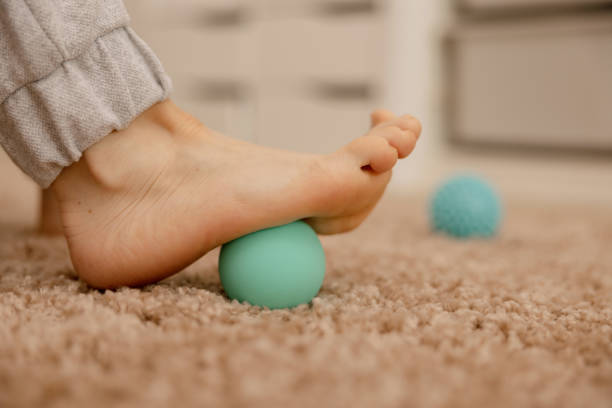In a well-aligned body, the foot arches serve a critical role in weight distribution, shock absorption, and stability. However, when the arches collapse, the body is forced to adapt in ways that disrupt its natural alignment. Specifically, flat feet lead to a biomechanical imbalance, where the ankle often rolls inward (a condition known as overpronation) and the knees, hips, and lower spine must compensate to keep the body stable. This repeated compensation strains the musculoskeletal system, often resulting in discomfort and chronic pain in the lumbar spine.
Individuals with flat feet typically experience changes in their gait (the way they walk), which affects the distribution of weight through each step. With each stride, the absence of proper arch support causes excessive force to travel up from the feet, through the knees, and into the hips and lower back. Over time, this additional stress can lead to muscle fatigue, ligament strain, and joint wear, particularly in the lower back, where these forces are concentrated.
The relationship between flat feet and low back pain is further compounded by poor posture and the need for increased stabilization. Without sufficient arch support, the feet struggle to maintain balance, prompting the back and core muscles to work harder to keep the body upright. This additional muscular effort can lead to muscle imbalances and tightness, especially in the lower back, hips, and thighs, ultimately contributing to chronic back pain.
While flat feet may seem like a minor issue, the impact on the spine and musculoskeletal system can be substantial. Physiotherapy offers a range of targeted solutions designed to address the root causes of pain by focusing on improving foot mechanics, strengthening muscles, and realigning the body. By restoring proper function and alignment, physiotherapy can effectively relieve low back pain associated with flat feet, providing patients with a path toward improved movement, balance, and overall comfort. Here, we’ll explore the biomechanics behind flat feet and how targeted physiotherapy at Urban Sports & Physio Centre can provide relief and restore function.

_____________________________________________________________________________________________________________________________________________________________________________________________________________________________________
Understanding How Flat Feet Cause Low Back Pain
- Biomechanical Chain Reaction
- Muscular Strain and Imbalances
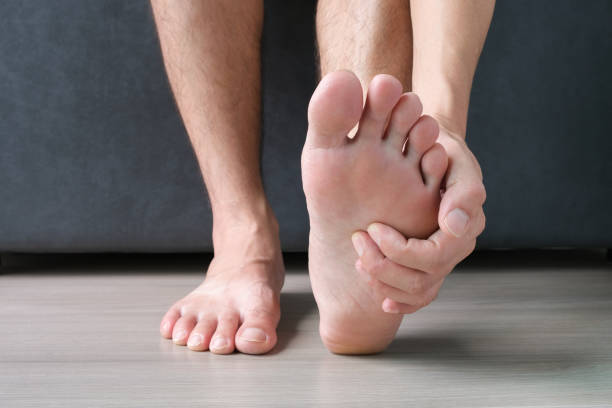
- Impact on Spinal Alignment and Posture
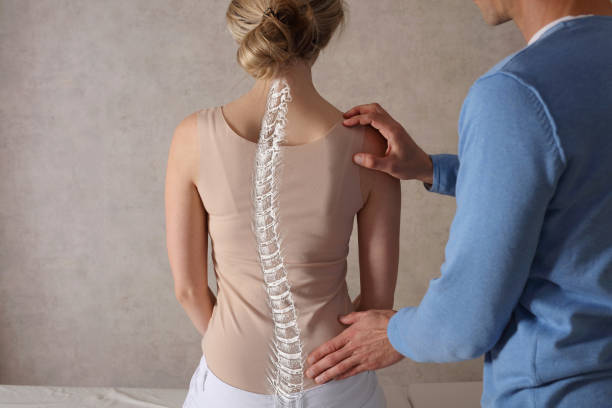
____________________________________________________________________________________________________________________________________________________________________________________________________________________________________
Physiotherapy Solutions to Address Flat Feet and Low Back Pain
- Custom Orthotic Insoles for Arch Support
- Purpose: Orthotic insoles are specifically designed to provide support where it is lacking. For individuals with flat feet, orthotics can raise the arch and promote proper alignment of the foot and ankle, reducing overpronation.
- Process: Physiotherapists or podiatrists assess foot structure and gait to create custom orthotics. These insoles are tailored to correct foot mechanics, thereby minimizing stress that travels up to the lower back. Over time, this supportive correction can relieve discomfort and prevent further alignment issues.
- Types of Orthotics: Depending on individual needs, orthotics may vary from semi-rigid for additional stability to cushioned ones for added comfort.
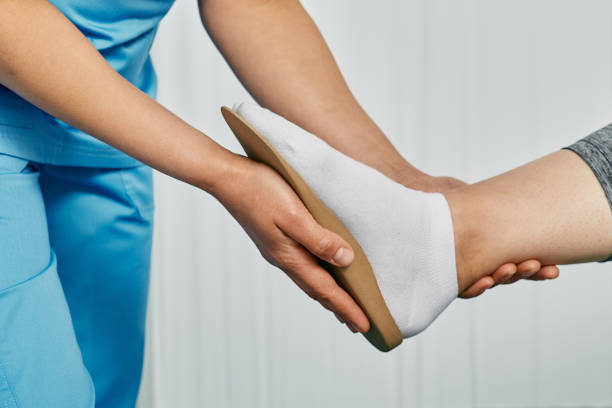
- Targeted Strengthening Exercises
- Focus on Foot and Leg Muscles: Strengthening the intrinsic muscles of the feet and lower legs can enhance foot stability, supporting the arches more effectively. Exercises like toe curls, marble pickups, and heel-to-toe walking help strengthen these muscles.
- Core Strengthening: The core muscles, especially the transversus abdominis and multifidus, play a pivotal role in maintaining a stable lower back. By reinforcing these muscles, the lower back can better handle the altered forces from flat feet
- Glute and Hip Muscles: Strong glutes and hip muscles help in maintaining proper alignment and prevent compensatory movements. Exercises like bridges, clamshells, and lateral leg raises are beneficial for flat-footed individuals to help alleviate low back strain.
- Stretching Exercises to Release Tension
- Calf Muscles: The Achilles tendon and calf muscles are often tight in flat-footed individuals, which can exacerbate overpronation. Stretching exercises, like the calf stretch against a wall, help in maintaining flexibility and relieving tension.
-
- Hip Flexors and Lower Back Muscles: These muscles are often tight due to compensatory posture from flat feet. Stretches like the hip flexor stretch (lunging stretch) and cat-cow stretch for the spine help in reducing tightness and promoting healthy spinal alignment.
- Hamstrings: Tight hamstrings can worsen low back pain by pulling the pelvis into a posterior tilt. Regular hamstring stretches can help relieve tension and improve posture.
- Manual Therapy for Pain Relief and Alignment Correction
- Massage and Myofascial Release: Flat-footed individuals often benefit from myofascial release to reduce muscle tightness in the legs, hips, and lower back. Physiotherapists may apply massage techniques to release tension and improve blood flow, helping alleviate pain and stiffness.
- Joint Mobilization: This involves gently moving the joints of the foot, ankle, and spine to improve their range of motion and alignment. Joint mobilization helps enhance overall movement quality and can relieve stiffness in both the foot and the lower back.
- Trigger Point Therapy: By applying pressure to trigger points in the lower back and leg muscles, physiotherapists can alleviate specific sources of pain related to muscle tightness and compensatory overuse.
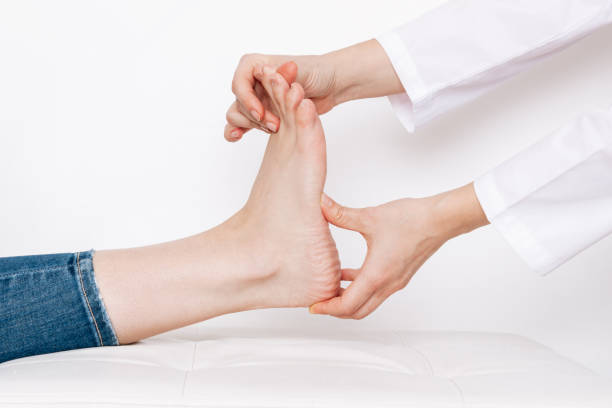
- Gait Training and Re-education
- Correcting the Gait Pattern: Physiotherapists work with patients to modify their walking patterns by focusing on proper foot placement and heel-to-toe movement. This reduces overpronation and encourages even distribution of body weight.
- Use of Tactile Cues and Visual Feedback: Therapists may use visual aids like mirrors or tactile cues to help individuals become more aware of their walking mechanics. This training helps patients develop new habits that reduce the impact on the lower back.
- Balance and Coordination Exercises: Exercises like single-leg stands, wobble board activities, and lateral foot taps help improve stability and control, which are essential for maintaining a healthy gait.
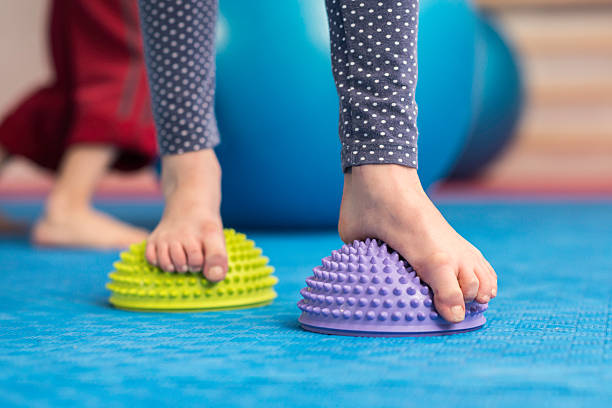
- Posture Correction and Ergonomic Education
- Standing and Walking Posture: Physiotherapists educate patients on maintaining a neutral spine and aligned posture while standing and walking. By adjusting posture, patients can reduce the stress on the lumbar spine from flat feet.
- Sitting Posture for Back Support: Given the increased likelihood of low back pain, proper seating ergonomics are crucial. Patients are guided on selecting chairs with lumbar support or using a lumbar roll to encourage a neutral spine.
- Exercises for Posture Awareness: Incorporating activities like wall angels and seated rotations can help patients become more aware of their body alignment, encouraging better postural habits throughout the day.
- Pain Management Techniques
- Heat Therapy: Applying heat to the lower back muscles can help relieve muscle stiffness and pain caused by compensatory movements from flat feet. Heat therapy increases blood flow, promoting relaxation and reducing discomfort.
- Electrical Stimulation (TENS): Transcutaneous Electrical Nerve Stimulation (TENS) is sometimes used to manage lower back pain by interfering with the body’s pain signals, providing relief and improving function.
- Patient Education on Self-Care: Physiotherapists often instruct patients on at-home strategies to manage their symptoms, such as using a foam roller to release tight muscles or applying ice after physical activity.
.png)
____________________________________________________________________________________________________________________________________________________________________________________________________________________________________
Urban Sports & Physio Centre in Johor Bahru offers cutting-edge physiotherapy techniques and personalized care. We provide a holistic approach, combining advanced technology and hands-on therapy to help you regain mobility, correct posture, and alleviate chronic pain. Our team is committed to helping you understand the connection between your foot structure and back pain, empowering you with knowledge and strategies to prevent recurrence.
____________________________________________________________________________________________________________________________________________________________________________________________
Conclusion
Flat feet, while often seen as a minor structural issue, can have a profound impact on your body’s alignment, posture, and overall well-being. The link between flat feet and low back pain may not be immediately obvious, but the strain caused by misalignment can lead to chronic discomfort if left untreated. Ignoring this connection can result in persistent back pain, muscle fatigue, and limitations in daily activities. By addressing the root cause through physiotherapy, you’re not only treating the pain but also preventing future complications.
Urban Sports & Physio Centre understands the unique challenges associated with flat feet and back pain. Our team of skilled physiotherapists offers a comprehensive, personalized approach that goes beyond temporary pain relief. We emphasize correction, strengthening, and education, so you gain the tools and awareness to maintain a healthier posture and movement pattern in the long term. From customized orthotics to targeted exercises, our therapies are designed to support your entire musculoskeletal system and improve your quality of life.
If you’ve been living with low back pain, don’t let it become a permanent part of your life. Instead, take control of your health with expert guidance from Urban Sports & Physio Centre. Our holistic physiotherapy approach can help you regain confidence, mobility, and comfort, empowering you to lead an active and fulfilling lifestyle. Reach out today to start your journey toward a pain-free future and discover how our flat feet solutions can bring lasting relief to your low back pain.
#FlatFeetSolutions #BackPainRelief #FootHealth #LowBackPainTreatment #PostureCorrection #UrbanSportsPhysioJB #PhysiotherapyForPain #FootAndBackAlignment #FlatFeetTreatment #FootStructureMatters #PhysioCare #PainFreeMovement #BackPainRecovery #FootPainRelief #PostureAndPain #HealthyPostureWithPhysio #PhysioForFlatFeet #FootSupportForBackPain #JohorBahruPhysio





